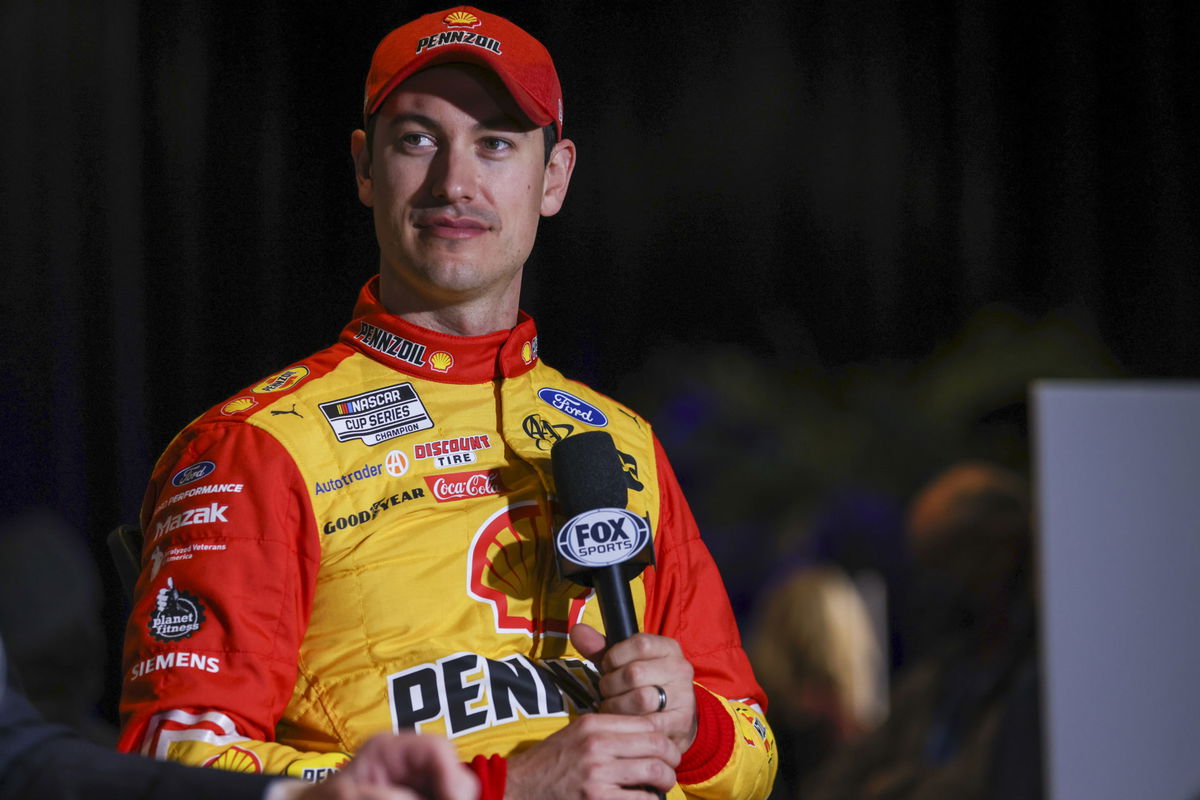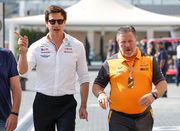
Getty
DAYTONA, FL – FEBRUARY 16: Joey Logano, driver of the #22 Pennzoil Team Penske Ford Mustang Shell, fields questions from the media during Daytona 500 Media Day on February 16, 2022 at Daytona International Speedway in Daytona Beach, Fl. (Photo by David Rosenblum/Icon Sportswire via Getty Images)

Getty
DAYTONA, FL – FEBRUARY 16: Joey Logano, driver of the #22 Pennzoil Team Penske Ford Mustang Shell, fields questions from the media during Daytona 500 Media Day on February 16, 2022 at Daytona International Speedway in Daytona Beach, Fl. (Photo by David Rosenblum/Icon Sportswire via Getty Images)
The big talking point after Sunday’s race was how track limits have been violated by drivers and what NASCAR can do to put a tab on it. Industry experts have made several suggestions, and joining the train now is Team Penske driver Joey Logano. While he made some valid points at the same time he even spoke about the advantage the NextGen car holds over its F1 counterpart.
Watch What’s Trending Now!
NASCAR is in a pickle about their role and approach to officiating the race at COTA. However, given how drivers flouted the rules and officials had to reprimand many violators, it is difficult to find a solution that works better at road course venues like COTA.
ADVERTISEMENT
The advantage NextGen has over F1 cars at COTA according to Joey Logano
NASCAR is trying to avoid calling out penalties every lap of the race, according to Elton Swayer. This then leaves room for drivers to constantly push their luck in trying to gain a track position at the 3.4-mile race track, which is treacherous on the turn. The track limits were only enforced at the esses and not the entirety of the race track.
Despite that, officials had to deliver 40 penalties to the drivers, and this made the entire officiating procedure confusing and tedious at the same time. Sharing the solution to curb the issue, Logano, speaking on SiriusXM, said, “Anytime you are asking the sanctioning body of any sport to make a call, it stinks. Like nobody wants that… To me, add some curbs that are big enough where we’ll not go to the other side of it. We kind of lived that part of the story a little bit from 3, 4, 5, 6 those were the areas that they were calling on the penalties.”
Top Stories
F1 Gets Golden Andretti Advice as Red Bull’s Sergio Perez Strategy Promises American Boost in the Sport

Aston Martin Tease Max Verstappen’s Rumored Arrival Amidst Lawrence Stroll’s $100 Million Adrian Newey Deal

Zak Brown & McLaren Possibly in Deep Trouble as Mercedes Cuts Engine Supply for F1 2026

Hollywood Star Not Holding Back Against Zak Brown in Lando Norris Championship Fiasco

Speculations Run Wild over DJ Lando’s Music Career as Max Verstappen Joins Martin Garrix’s Entourage

Newsflash: #NASCAR ain't F1 😂
🗯️ "We can put cars where they can't […] we gotta look into it and look at a better way of doing it for @COTA."
More from @joeylogano on track limits → https://t.co/keYsFmuVzu pic.twitter.com/kijn6SSEwI
— SiriusXM NASCAR Radio (Ch. 90) (@SiriusXMNASCAR) March 28, 2024
ADVERTISEMENT
Logano even revealed the reason why NASCAR drivers can pull off the antics at COTA. “We’ll F1 doesn’t need it and F1 doesn’t do it, they can’t even touch the curbs, ok. Their cars are so different than ours. We are monster trucks compared to an F1 car; you can ram these things. I was four tiers in the sky by a foot, you imagine an F1 car do that. They park it if they have a loose wheel, like that’s it. We’re jumping this thing every single lap.”
However, one thing we can all agree on is that F1 has been able to implement track limits to good use, and NASCAR can learn a thing or two from them.
ADVERTISEMENT
Here’s how track limits work in Formula 1
Track limits in F1 are the edge of the racetrack, and without them, drivers could cut corners and gain an unfair advantage. All four wheels of the car cannot extend beyond the marked borders, and if they do so, the stewards can serve the drivers with penalties. The interesting element at play here is that during the race, each driver is allowed three track limit violations before they are penalized.
However, if the driver repeatedly exceeds those limits for the fourth time, a five-second penalty is brandished by the officials. Whereas, a fifth violation will see the penalty time increase to ten seconds, which seems like an eternity for an F1 car. It was last year when the driver demanded a permanent track limit fix at COTA, where a total of 17 laps were deleted.
ADVERTISEMENT
What are your views regarding the track limit violation at COTA, and how can NASCAR better deal with it for the upcoming road course races for the season?
Read More: Joey Logano gets Candid on his Worst Early Season Slump in 16-Years Career
ADVERTISEMENT
ADVERTISEMENT
ADVERTISEMENT

